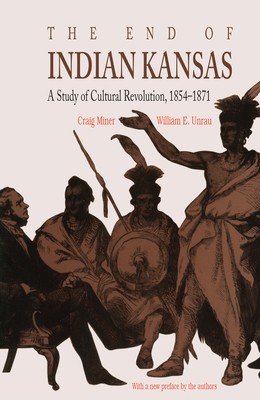
- We will send in 10–14 business days.
- Author: Craig Miner
- Publisher: University Press Of Kansas
- ISBN-10: 070060474X
- ISBN-13: 9780700604746
- Format: 14.1 x 21.7 x 1.2 cm, minkšti viršeliai
- Language: English
- SAVE -10% with code: EXTRA
Reviews
Description
When Kansas became a U.S. territory in 1854 literally all of its land area was guaranteed by treaty to Indians. More than 10,000 Kickapoos, Delawares, Sacs, Foxes, Shawnees, Potawatomis, Kansas, Ottawas, Wyandots, and Osages, not to mention a number of smaller tribes, inhabited Kansas. By 1875 there were only a couple of bands left.
The forced removal of thousands of Indians from eastern Kansas between 1854 and 1871 affected more Indians and occupied more government time than the celebrated exploits of the military against the more warlike western tribes. In this volume Miner and Unrau show Kansas at mid-century to be a moral testing ground where the drama of Indian disinheritance was played out. They relate how railroad men, land speculators, and timber operations came to be firmly entrenched on Indian land in territorial Kansas. They examine remarkable incongruities in Indian policy, land policy, law, and administration, pointing to specific cases in which legal maneuvers by the federal government--within the framework of treaties, statutes, and executive pronouncements--helped to insure the pattern of tribal destruction. Separate chapters deal with internal factionalism in the Indian tribes, the practice of government chief-making, and the "Indian Ring"--the sub rosa alliances influencing the treaty or sale process. The authors also include revealing portraits of the individuals, from territorial governors to railroad officials, who helped engineer the end of Indian Kansas. "The reader's perception of those brave, hard-working sod-house settlers may never be the same after reading this book."--American West.EXTRA 10 % discount with code: EXTRA
The promotion ends in 23d.10:31:48
The discount code is valid when purchasing from 10 €. Discounts do not stack.
- Author: Craig Miner
- Publisher: University Press Of Kansas
- ISBN-10: 070060474X
- ISBN-13: 9780700604746
- Format: 14.1 x 21.7 x 1.2 cm, minkšti viršeliai
- Language: English English
When Kansas became a U.S. territory in 1854 literally all of its land area was guaranteed by treaty to Indians. More than 10,000 Kickapoos, Delawares, Sacs, Foxes, Shawnees, Potawatomis, Kansas, Ottawas, Wyandots, and Osages, not to mention a number of smaller tribes, inhabited Kansas. By 1875 there were only a couple of bands left.
The forced removal of thousands of Indians from eastern Kansas between 1854 and 1871 affected more Indians and occupied more government time than the celebrated exploits of the military against the more warlike western tribes. In this volume Miner and Unrau show Kansas at mid-century to be a moral testing ground where the drama of Indian disinheritance was played out. They relate how railroad men, land speculators, and timber operations came to be firmly entrenched on Indian land in territorial Kansas. They examine remarkable incongruities in Indian policy, land policy, law, and administration, pointing to specific cases in which legal maneuvers by the federal government--within the framework of treaties, statutes, and executive pronouncements--helped to insure the pattern of tribal destruction. Separate chapters deal with internal factionalism in the Indian tribes, the practice of government chief-making, and the "Indian Ring"--the sub rosa alliances influencing the treaty or sale process. The authors also include revealing portraits of the individuals, from territorial governors to railroad officials, who helped engineer the end of Indian Kansas. "The reader's perception of those brave, hard-working sod-house settlers may never be the same after reading this book."--American West.

Reviews